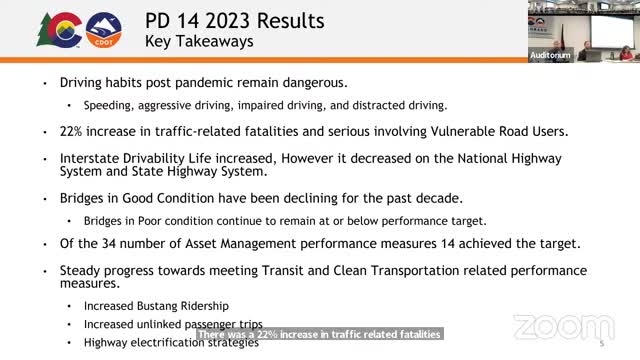Statewide Traffic Fatalities Rise Amid Safety Concerns
August 15, 2024 | Transportation Commission, Governor's Boards and Commissions, Organizations, Executive, Colorado
This article was created by AI summarizing key points discussed. AI makes mistakes, so for full details and context, please refer to the video of the full meeting. Please report any errors so we can fix them. Report an error »

During a recent government meeting, officials discussed the current state of transportation infrastructure, highlighting both progress and ongoing challenges. The meeting revealed a mixed picture regarding pavement conditions, with interstate drivability life showing improvement, while conditions on the National Highway System and state highways have declined. Notably, bridges in good condition have been on a downward trend for the past decade, although those in poor condition have remained below performance targets.
Out of 34 asset management performance measures, 14 have met their targets, with significant strides made in transit and clean transportation metrics, including increased bus ridership and linked passenger trips due to highway electrification strategies. However, the meeting underscored a concerning rise in risky driving behaviors post-pandemic, with serious injuries increasing by 5% and a notable 22.4% rise in fatalities among vulnerable road users, such as pedestrians and cyclists.
The meeting also addressed employee safety, reporting a remarkable 106% decrease in vehicle incidents involving transportation department employees. In terms of asset management, pavement conditions slightly fell below targets due to recalibrated reporting methods, but improvements were made on 265 interstate lane miles, reducing the number of poor interstate lane miles.
Bridge conditions remain a priority, with investments aimed at preventing fair bridges from deteriorating further. The department is also focusing on bridge risk management, noting an upward trend in leaking expansion joints, while unsealed deck areas have decreased due to maintenance efforts.
The maintenance level of service has remained stable, with snow and ice removal receiving commendations despite heavy snowfall in 2023. Additionally, the department allocated $65 million in federal funds to address deteriorating culverts, aiming to reduce the percentage of poor structures.
The meeting concluded with discussions on mobility, revealing a return to pre-pandemic vehicle miles traveled per capita, alongside a 50% increase in electric vehicle registrations. Statewide transit remains a priority, with significant ridership numbers reported for the Bustang service.
Overall, the meeting highlighted the ongoing efforts to enhance transportation safety and infrastructure while addressing the challenges posed by aging assets and changing travel patterns.
Out of 34 asset management performance measures, 14 have met their targets, with significant strides made in transit and clean transportation metrics, including increased bus ridership and linked passenger trips due to highway electrification strategies. However, the meeting underscored a concerning rise in risky driving behaviors post-pandemic, with serious injuries increasing by 5% and a notable 22.4% rise in fatalities among vulnerable road users, such as pedestrians and cyclists.
The meeting also addressed employee safety, reporting a remarkable 106% decrease in vehicle incidents involving transportation department employees. In terms of asset management, pavement conditions slightly fell below targets due to recalibrated reporting methods, but improvements were made on 265 interstate lane miles, reducing the number of poor interstate lane miles.
Bridge conditions remain a priority, with investments aimed at preventing fair bridges from deteriorating further. The department is also focusing on bridge risk management, noting an upward trend in leaking expansion joints, while unsealed deck areas have decreased due to maintenance efforts.
The maintenance level of service has remained stable, with snow and ice removal receiving commendations despite heavy snowfall in 2023. Additionally, the department allocated $65 million in federal funds to address deteriorating culverts, aiming to reduce the percentage of poor structures.
The meeting concluded with discussions on mobility, revealing a return to pre-pandemic vehicle miles traveled per capita, alongside a 50% increase in electric vehicle registrations. Statewide transit remains a priority, with significant ridership numbers reported for the Bustang service.
Overall, the meeting highlighted the ongoing efforts to enhance transportation safety and infrastructure while addressing the challenges posed by aging assets and changing travel patterns.
View full meeting
This article is based on a recent meeting—watch the full video and explore the complete transcript for deeper insights into the discussion.
View full meeting
